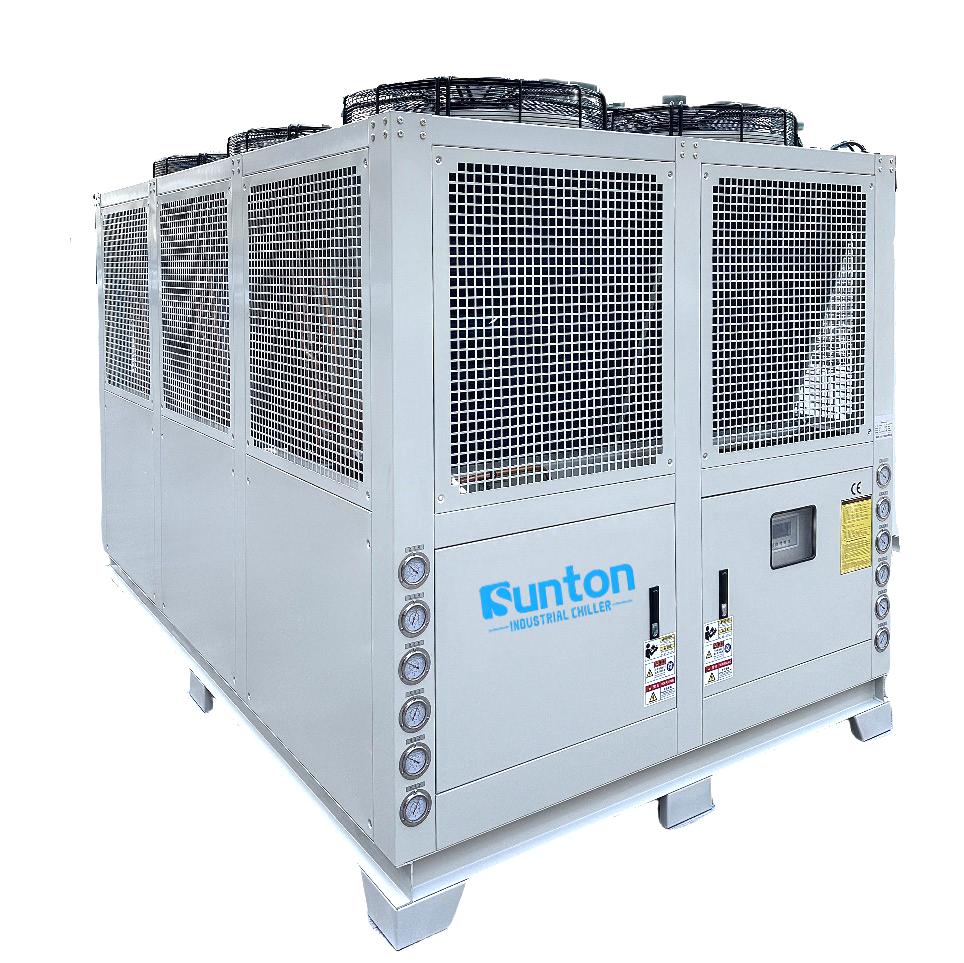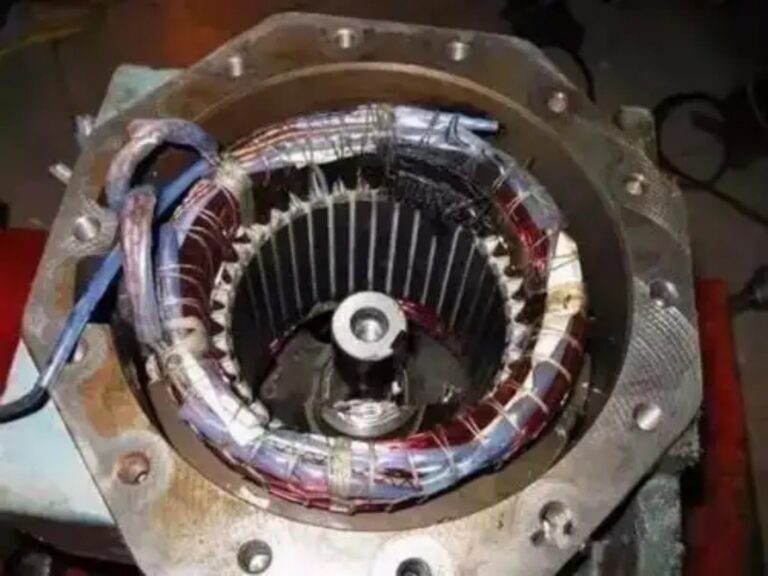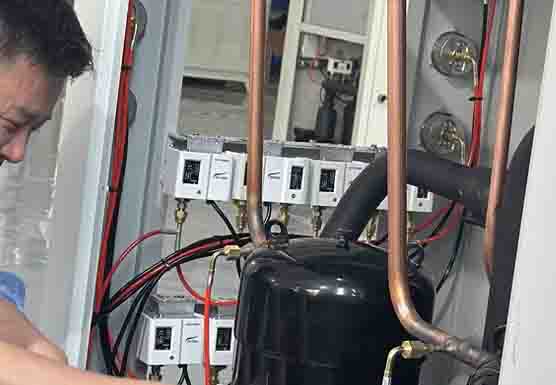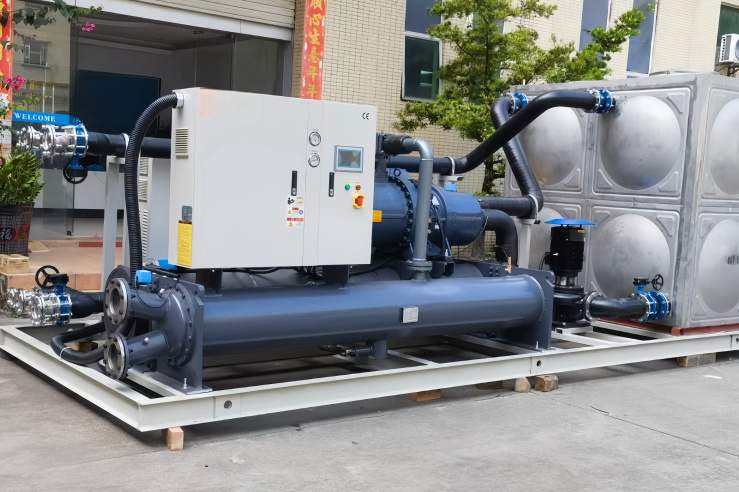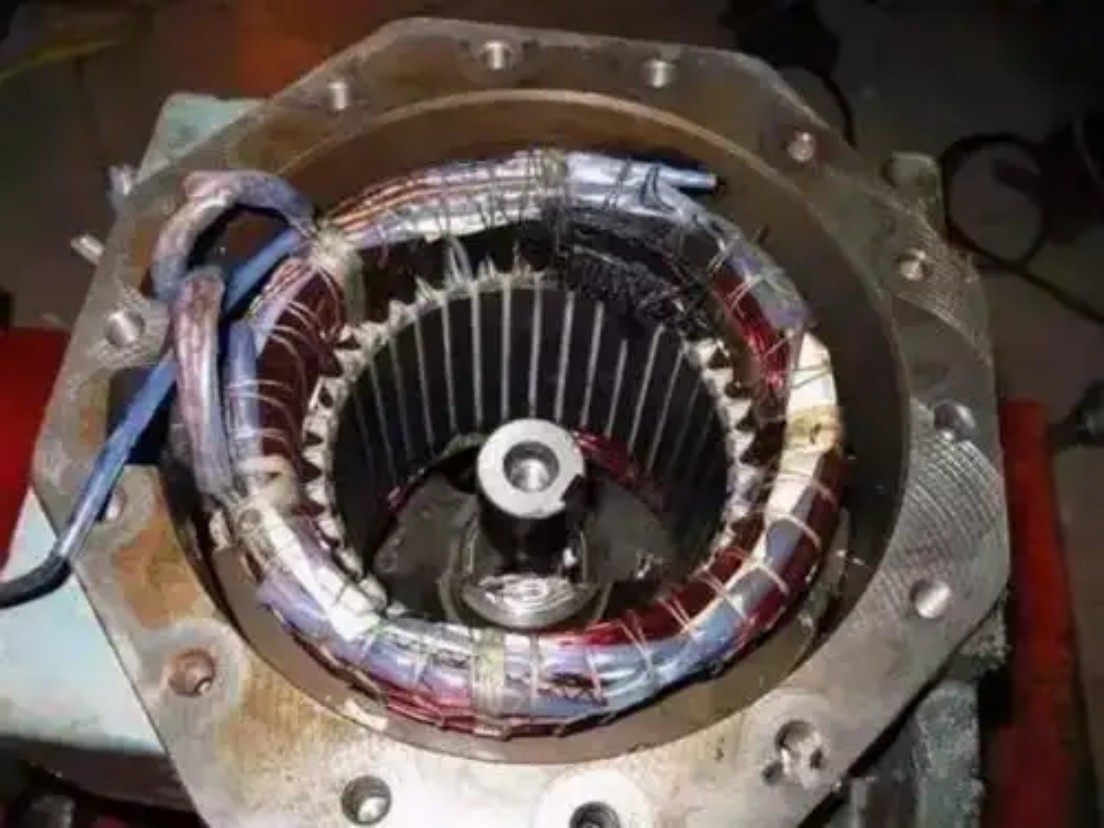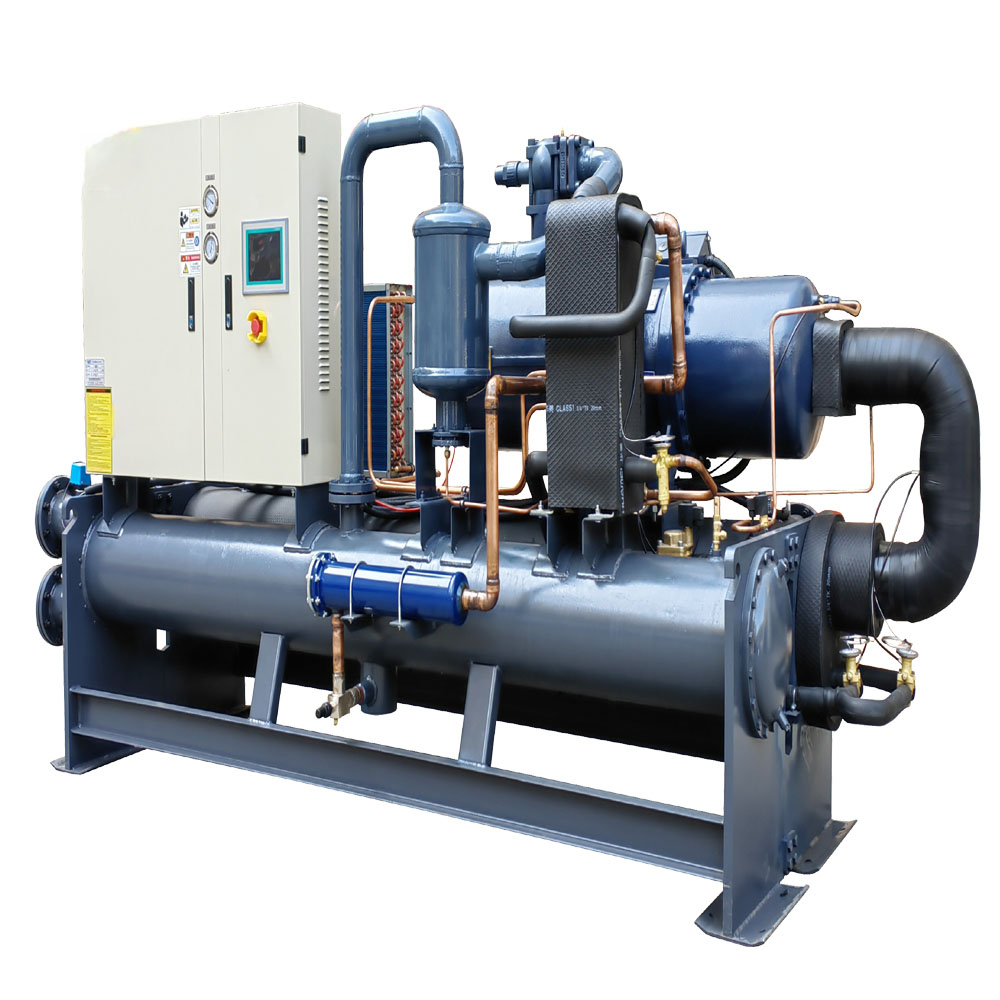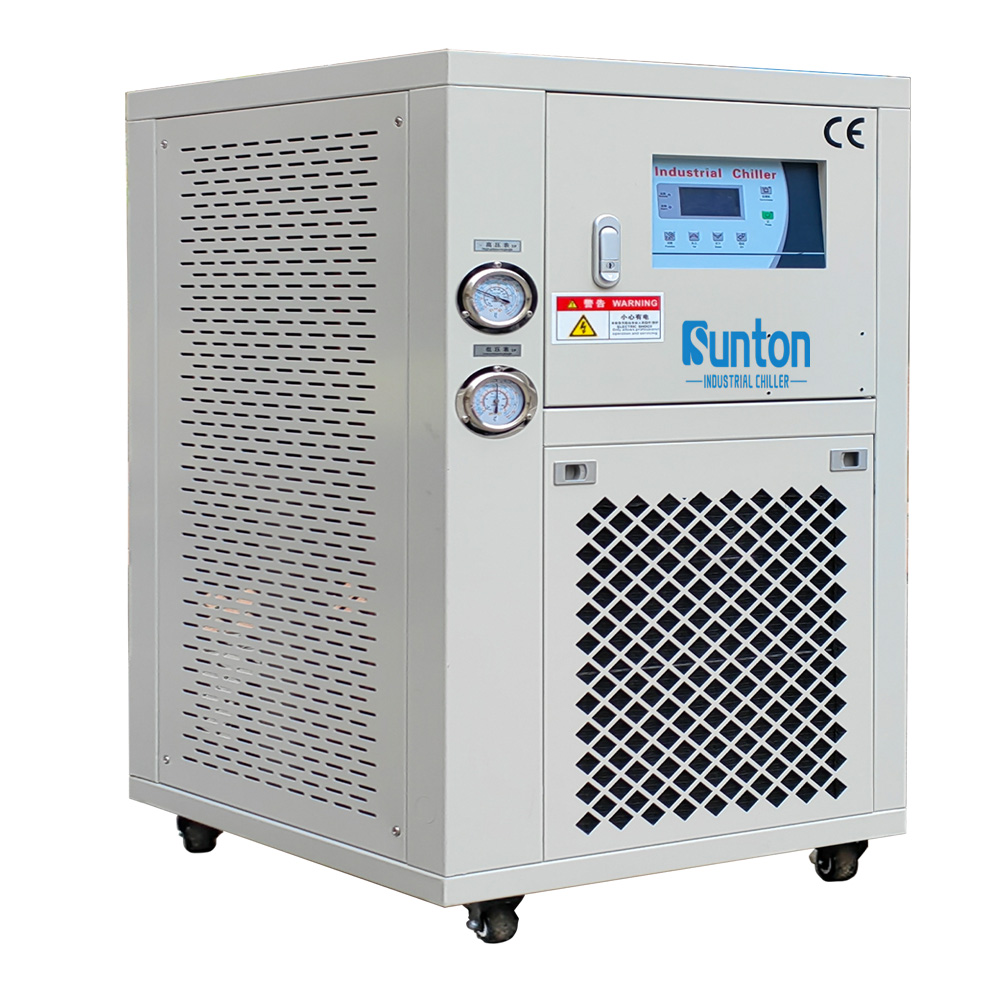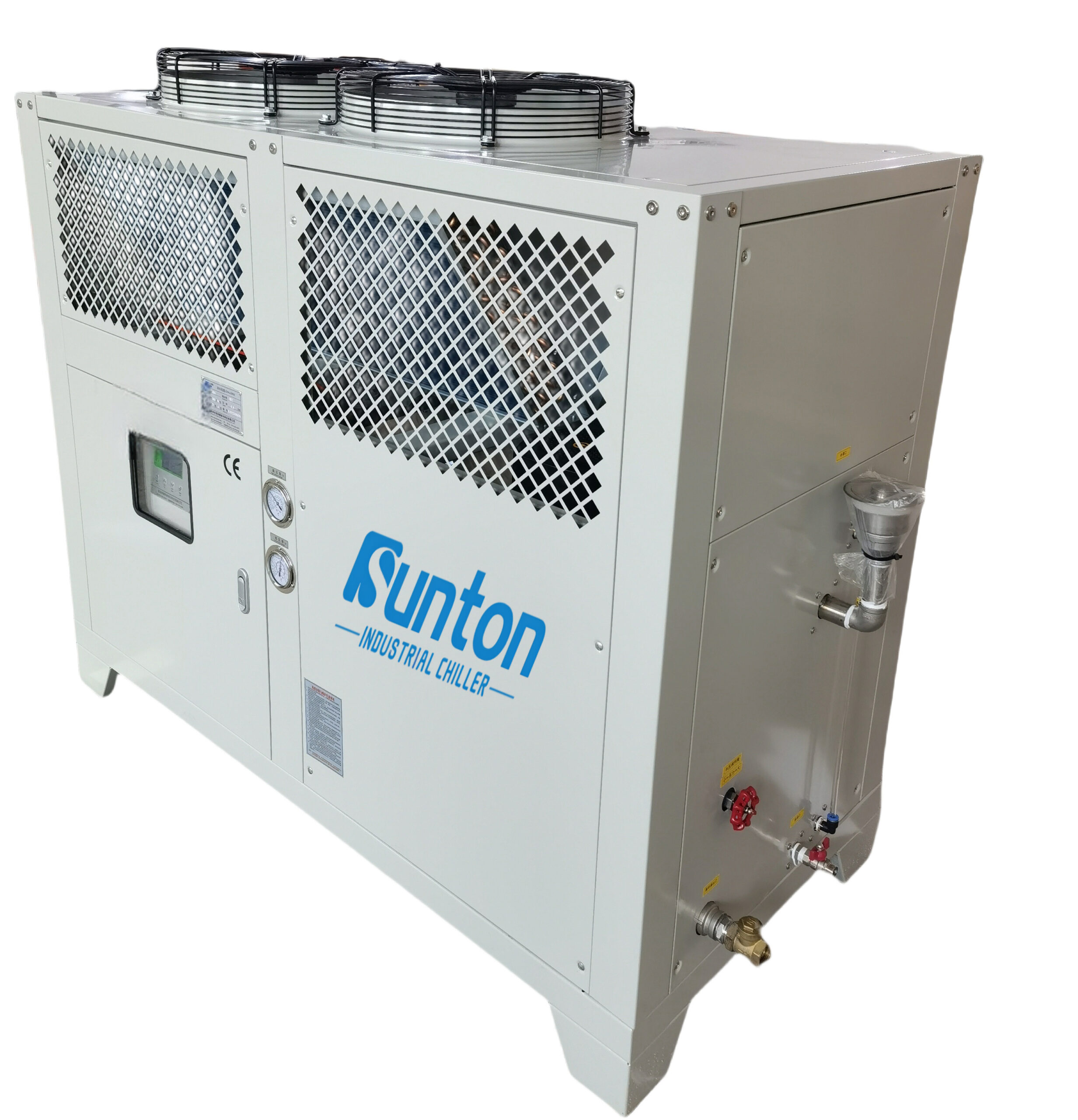-
ডালিংশান ইন্ডাস্ট্রিয়াল গুয়াংডং
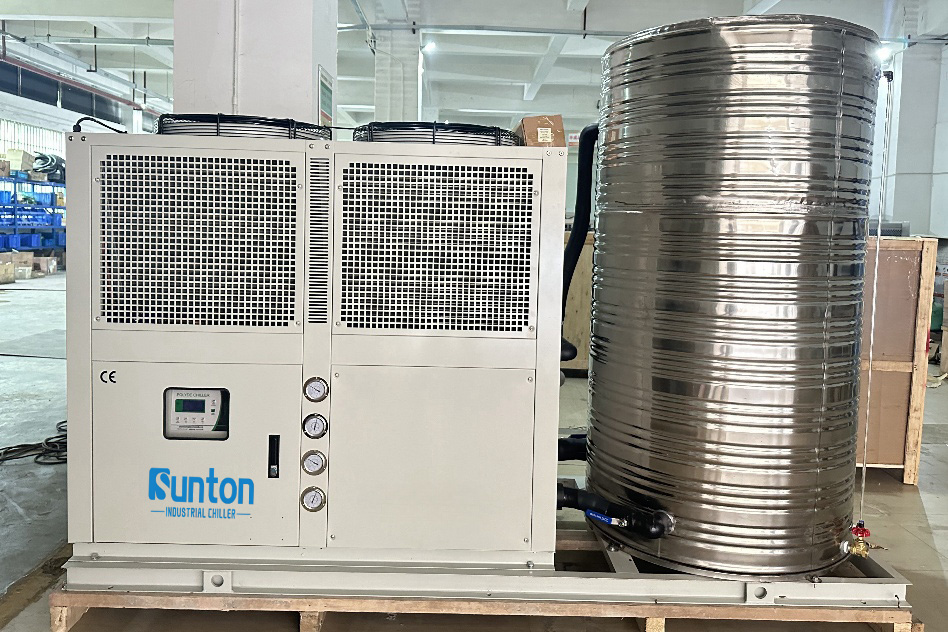
এয়ার-কুলড চিলার বনাম ওয়াটার-কুলড চিলারের মধ্যে পার্থক্য
এয়ার-কুলড বনাম ওয়াটার-কুলড চিলার: আপনার শিল্প চাহিদার জন্য কোনটি সঠিক?
এই নিবন্ধটি শিল্প চিলারের জগতে অনুসন্ধান করে, তুলনা করে এয়ার-কুলড এবং জল-ঠান্ডা আপনার নির্দিষ্ট প্রয়োগের জন্য একটি সুনির্দিষ্ট সিদ্ধান্ত নিতে সাহায্য করার জন্য সিস্টেম। আপনি প্লাস্টিক, খাদ্য, রাসায়নিক, অথবা অন্য কোনও শিল্পে থাকুন যেখানে সুনির্দিষ্ট তাপমাত্রা নিয়ন্ত্রণের প্রয়োজন হয়, এই দুই ধরণের মধ্যে সূক্ষ্মতাগুলি বোঝা চিলার একজন অভিজ্ঞ বিশেষজ্ঞ হিসেবে শিল্প জল চিলার উৎপাদন, আমি সরাসরি দেখেছি কিভাবে সঠিকটি বেছে নেওয়া যায় শীতলকারী দক্ষতা, খরচ এবং সামগ্রিক পরিচালন সাফল্যের উপর উল্লেখযোগ্য প্রভাব ফেলতে পারে। এই প্রবন্ধটি পড়ার যোগ্য কারণ এটি বছরের পর বছর অভিজ্ঞতার ভিত্তিতে আমার ব্যক্তিগত অন্তর্দৃষ্টি প্রদান করে, যা আপনাকে সাধারণ সমস্যাগুলি এড়াতে এবং আপনার দীর্ঘমেয়াদী লক্ষ্যগুলির সাথে সামঞ্জস্যপূর্ণ সিদ্ধান্ত নিতে সহায়তা করে।
সুচিপত্র
চিলার কী এবং কেন এটি আপনার শিল্পের জন্য অপরিহার্য?
ক শীতলকারী একটি যন্ত্র যা বাষ্প-সংকোচন বা শোষণ রেফ্রিজারেশন চক্রের মাধ্যমে তরল থেকে তাপ অপসারণ করে। এই ঠান্ডা তরলটি তাপ এক্সচেঞ্জারের মাধ্যমে সঞ্চালিত হতে পারে শীতল সরঞ্জাম, অথবা অন্য কোন প্রক্রিয়া প্রবাহ (যেমন বায়ু বা প্রক্রিয়া জল)। শিল্পের একজন অভিজ্ঞ প্রস্তুতকারক হিসেবে জল চিলার, আমি আপনাকে বলতে পারি যে এগুলি অনেক শিল্প প্রক্রিয়ার মেরুদণ্ড। প্লাস্টিক এবং রাবার, মেশিনিং, খাদ্য ও পানীয়, রাসায়নিক ও ওষুধ, ইলেকট্রনিক্স, লেজার, মুদ্রণ, চিকিৎসা, পরীক্ষাগার এবং গবেষণা প্রতিষ্ঠান এবং ডেটা সেন্টারের মতো শিল্পগুলি সুনির্দিষ্ট তাপমাত্রা নিয়ন্ত্রণের উপর ব্যাপকভাবে নির্ভর করে যা চিলার প্রদান।
উদাহরণস্বরূপ, প্লাস্টিক শিল্পে, চিলার অভ্যস্ত শীতল ছাঁচে ঢোকানো গরম প্লাস্টিক। দ্রুত শীতলকরণ পণ্যের ধারাবাহিকতা নিশ্চিত করে এবং চক্রের সময় কমায়, যা সরাসরি উৎপাদনশীলতার উপর প্রভাব ফেলে। একইভাবে, খাদ্য ও পানীয় শিল্পে, চিলার পণ্যের মান এবং নিরাপত্তা বজায় রাখার জন্য গুরুত্বপূর্ণ, যেমন আমাদের ডেইরি মিল্ক চিলারনির্ভরযোগ্য ছাড়া শীতলকরণ, প্রক্রিয়াগুলি ব্যাহত হতে পারে, যার ফলে উল্লেখযোগ্য আর্থিক ক্ষতি এবং সম্ভাব্য নিরাপত্তা ঝুঁকি দেখা দিতে পারে।
চিলার কিভাবে কাজ করে? মৌলিক নীতিগুলি বোঝা
চিলার কাজ করে তাপ স্থানান্তরের জন্য একটি রেফ্রিজারেটর সিস্টেম ব্যবহার করে। মূল নীতিতে একটি রেফ্রিজারেটর অন্তর্ভুক্ত যা তাপ শোষণ এবং ছেড়ে দেওয়ার জন্য বিভিন্ন অবস্থার (তরল এবং গ্যাস) মধ্য দিয়ে চক্রাকারে যায়। দুটি প্রধান প্রকার রয়েছে চিলার: এয়ার-কুলড এবং জল-ঠান্ডা। দ্য জল-শীতল এবং বায়ু-শীতল চিলারের মধ্যে পার্থক্য তারা কীভাবে শোষিত তাপকে অপচয় করে তার উপর নির্ভর করে রেফ্রিজারেন্ট.
সহজ ভাষায়, একটি শীতলকারী একটি অবিচ্ছিন্ন লুপে কাজ করে। রেফ্রিজারেন্ট প্রক্রিয়াজাত জল থেকে তাপ শোষণ করে (অথবা ঠান্ডা পানি), যা পানির তাপমাত্রা কমিয়ে দেয়। তাপ-সমৃদ্ধ রেফ্রিজারেন্ট তারপর ভ্রমণ করে কনডেন্সার, যেখানে তাপ আশেপাশের পরিবেশে নির্গত হয় পরিবেশগত বায়ু (এয়ার-কুলড চিলার) অথবা আলাদাভাবে পানি উৎস যেমন একটি কুলিং টাওয়ার (জল-ঠান্ডা চিলার)। এই প্রক্রিয়াটি পুনরাবৃত্তি করে, একটি ধারাবাহিক সরবরাহ নিশ্চিত করে ঠান্ডা পানি শিল্প অ্যাপ্লিকেশনের জন্য। আমাদের চিলার, যেমন ওয়াটার কুলড স্ক্রু সেন্ট্রাল চিলার, কার্যকর তাপ স্থানান্তরের উদাহরণ দিন।
একটি চিলার সিস্টেমের প্রধান উপাদানগুলি কী কী?
একটি সাধারণ শীতলকারী ব্যবস্থা বেশ কয়েকটি কী নিয়ে গঠিত চিলার উপাদান: কম্প্রেসার, কনডেন্সার, সম্প্রসারণ ভালভ, এবং বাষ্পীভবনকারী। কম্প্রেসার হল সিস্টেমের হৃদয়, যা পাম্প করে রেফ্রিজারেন্ট সর্বত্র শীতলকারী। দ্য কনডেন্সার যেখানে তাপ প্রত্যাখ্যান করা হয়, এবং এটি যেকোনো একটি হতে পারে এয়ার-কুলড অথবা জল-ঠান্ডা। সম্প্রসারণ ভালভ প্রবাহ নিয়ন্ত্রণ করে রেফ্রিজারেন্ট, যখন বাষ্পীভবনকারী যেখানে রেফ্রিজারেন্ট প্রক্রিয়াজাত জল থেকে তাপ শোষণ করে, যার ফলে শীতলকরণ এটা।
এই প্রাথমিক উপাদানগুলি ছাড়াও, শীতলকারী সিস্টেমগুলিতে পাম্প, নিয়ন্ত্রণ এবং অন্যান্য আনুষাঙ্গিক অন্তর্ভুক্ত থাকতে পারে। উদাহরণস্বরূপ, জল-ঠান্ডা সিস্টেমগুলির প্রায়শই প্রয়োজন হয় কুলিং টাওয়ার এবং কনডেন্সার ওয়াটার পাম্প শীতলতা সঞ্চালনের জন্য পানিএগুলো বোঝা চিলার উপাদান মধ্যে পার্থক্যগুলি বোঝা অপরিহার্য এয়ার-কুলড চিলার এবং ওয়াটার-কুলড চিলার। প্রতিটি অংশ সামগ্রিক দক্ষতা এবং কর্মক্ষমতা বৃদ্ধিতে গুরুত্বপূর্ণ ভূমিকা পালন করে শীতলকারী.
জল-ঠান্ডা চিলারের গভীরে ডুব দিন: বৈশিষ্ট্য, সুবিধা এবং বিবেচনা
জল-ঠান্ডা চিলার উচ্চ দক্ষতার জন্য পরিচিত, বিশেষ করে উচ্চতর শীতল ক্ষমতার প্রয়োজন এমন অ্যাপ্লিকেশনগুলিতে। তারা একটি ব্যবহার করে জলের উৎস, যেমন একটি কুলিং টাওয়ার অথবা একটি নিবেদিতপ্রাণ পানি লুপ, তাপ অপচয় করতে রেফ্রিজারেন্ট। দ্য পানি তাপ শোষণ করে এবং তারপর ঠান্ডা হয় কুলিং টাওয়ার ফিরে আসার আগে শীতলকারীআমার অভিজ্ঞতা থেকে, জল-ঠান্ডা চিলারগুলি সাধারণত এর চেয়ে বেশি শক্তি-সাশ্রয়ী এয়ার-কুলড প্রতিরূপ, বিশেষ করে উষ্ণ জলবায়ুতে।
জল-ঠান্ডা চিলারের সুবিধা:
- উচ্চ দক্ষতা: জল-ঠান্ডা চিলার সাধারণত তুলনামূলকভাবে উচ্চতর কর্মক্ষমতা সহগ (COP) থাকে এয়ার-কুলড ইউনিট।
- স্থিতিশীল অপারেশন: তারা ওঠানামার দ্বারা কম প্রভাবিত হয় পরিবেশগত বায়ু তাপমাত্রা।
- নীরব অপারেশন: বড় পাখার অনুপস্থিতি তাদের তুলনায় শান্ত করে তোলে এয়ার-কুলড চিলার.
- দীর্ঘ জীবনকাল: সঠিক রক্ষণাবেক্ষণের মাধ্যমে, জল-ঠান্ডা চিলার দীর্ঘ কর্মক্ষম জীবন থাকতে পারে।
জল-ঠান্ডা চিলারের জন্য বিবেচ্য বিষয়গুলি:
- পানির প্রাপ্যতা: তাদের একটি নির্ভরযোগ্য প্রয়োজন জলের উৎস এবং যেখানে উপযুক্ত নাও হতে পারে জলের অভাব।.
- জল চিকিত্সা: নিয়মিত জল চিকিত্সা স্কেলিং, ক্ষয় এবং জৈবিক বৃদ্ধি রোধ করার জন্য প্রয়োজনীয়।
- প্রাথমিক খরচ: দ্য প্রাথমিক খরচ প্রয়োজনের কারণে বেশি হতে পারে কুলিং টাওয়ার এবং সংশ্লিষ্ট পাইপিং।
- রক্ষণাবেক্ষণ খরচ: কার্যকর হলেও, রক্ষণাবেক্ষণ খরচ এর কারণে বেশি হতে পারে জল চিকিত্সা এবং কুলিং টাওয়ার রক্ষণাবেক্ষণ।
- উচ্চতর শীতল ক্ষমতা।
আমাদের ওয়াটার কুলড স্ক্রোল ওয়াটার চিলার এই প্রযুক্তির দক্ষ শীতলকরণ ক্ষমতা তুলে ধরে।
এয়ার-কুলড চিলার অন্বেষণ: তারা কীভাবে তুলনা করে?
এয়ার-কুলড চিলারঅন্যদিকে, ব্যবহার করুন পরিবেশগত বায়ু থেকে শীতল দ্য রেফ্রিজারেন্ট. তারা ফুঁ দেওয়ার জন্য বড় পাখা ব্যবহার করে বায়ু ধারণকারী টিউবিংয়ের উপরে রেফ্রিজারেন্ট, এইভাবে তাপ অপচয় করে। এয়ার-কুলড চিলার ইনস্টল করা সহজ এবং এর প্রয়োজন হয় না কুলিং টাওয়ার অথবা একটি পৃথক পানি লুপ। এগুলি এমন এলাকায় একটি জনপ্রিয় পছন্দ যেখানে পানি সীমিত অথবা যেখানে প্রাথমিক খরচ একটি প্রধান উদ্বেগের বিষয়।
এয়ার-কুলড চিলারের সুবিধা:
- কম প্রাথমিক খরচ: সাধারণত, প্রাথমিক খরচ তুলনায় কম জল-ঠান্ডা সিস্টেম।
- সহজ ইনস্টলেশন: কোন প্রয়োজন নেই কুলিং টাওয়ার অথবা বিস্তৃত পাইপিং।
- নিম্ন রক্ষণাবেক্ষণ: কম উপাদান মানে কম রক্ষণাবেক্ষণ খরচ তুলনা করা জল-ঠান্ডা.
- পানি সংরক্ষণ: সীমিত অঞ্চলের জন্য আদর্শ পানি সম্পদ বা কোথায় জল সংরক্ষণ একটি অগ্রাধিকার।
এয়ার-কুলড চিলারের জন্য বিবেচ্য বিষয়গুলি:
- কম দক্ষতা: এগুলি সাধারণত এর চেয়ে কম দক্ষ জল-ঠান্ডা চিলার, বিশেষ করে গরম জলবায়ুতে।
- উচ্চ শব্দের মাত্রা: ফ্যানগুলি উল্লেখযোগ্য শব্দ উৎপন্ন করতে পারে।
- সংক্ষিপ্ত জীবনকাল: তুলনায় এদের জীবনকাল কম হতে পারে জল-ঠান্ডা ইউনিট, বিশেষ করে কঠোর পরিবেশে।
- পরিবেষ্টিত তাপমাত্রা দ্বারা প্রভাবিত কর্মক্ষমতা: উচ্চ মাত্রায় তাদের কর্মক্ষমতা উল্লেখযোগ্যভাবে হ্রাস পেতে পারে পরিবেশগত বায়ু তাপমাত্রা।
প্রচণ্ড তাপযুক্ত অঞ্চলে, এয়ার-কুলড সিস্টেমের দক্ষতা হ্রাস পেতে পারে, যেমনটি আমাদের সাথে দেখা গেছে এয়ার কুলড স্ক্রু সেন্ট্রাল চিলার.
এয়ার-কুলড চিলার বনাম ওয়াটার-কুলড চিলার: একটি বিস্তৃত তুলনা
দ্য এয়ার-কুলড চিলার এবং ওয়াটার-কুলড চিলারের মধ্যে পার্থক্য দক্ষতা, খরচ, রক্ষণাবেক্ষণ এবং পরিবেশগত প্রভাব: কয়েকটি মূল বিষয় বিবেচনা করে সংক্ষিপ্ত করা যেতে পারে।
| বৈশিষ্ট্য | এয়ার-কুলড চিলার | জল-ঠান্ডা চিলার |
| দক্ষতা | কম, বিশেষ করে গরম জলবায়ুতে | উচ্চতর, পরিবেশের তাপমাত্রার দ্বারা কম প্রভাবিত |
| প্রাথমিক খরচ | নিম্ন | উচ্চতর |
| রক্ষণাবেক্ষণ খরচ | নিম্ন | উচ্চতর |
| জল ব্যবহার | কোনটিই নয় | অবিরাম জল সরবরাহ প্রয়োজন |
| শব্দের মাত্রা | উচ্চতর | নিম্ন |
| জীবনকাল | সম্ভাব্যভাবে খাটো, বিশেষ করে কঠোর পরিবেশে | সঠিক রক্ষণাবেক্ষণের মাধ্যমে সম্ভবত দীর্ঘস্থায়ী হতে পারে |
| স্থাপন | সহজতর | আরও জটিল, কুলিং টাওয়ার এবং পাইপিং প্রয়োজন |
| পরিবেশগত প্রভাব | গরম জলবায়ুতে পানির প্রভাব কম, শক্তির ব্যবহার বেশি | বেশিরভাগ পরিস্থিতিতে জলের ব্যবহার বেশি, শক্তির ব্যবহার কম |
এয়ার-কুলড চিলার প্রায়শই তাদের নিম্ন স্তরের জন্য পছন্দ করা হয় প্রাথমিক খরচ এবং সহজ ইনস্টলেশন। এগুলি ছোট অ্যাপ্লিকেশন বা যেখানে উপযুক্ত পানি প্রাপ্যতা একটি উদ্বেগের বিষয়। বিপরীতে, জল-ঠান্ডা চিলার বৃহত্তর ইনস্টলেশনের জন্য পছন্দ করা হয় যেখানে উচ্চ দক্ষতা এবং স্থিতিশীল কর্মক্ষমতা অত্যন্ত গুরুত্বপূর্ণ। জল-ঠান্ডা চিলার যদি আপনার সুবিধার একটি নির্ভরযোগ্য পরিষেবার অ্যাক্সেস থাকে তবে এটি আরও ভালো পছন্দ হতে পারে জলের উৎস এবং উচ্চতর পরিচালনা করতে পারে রক্ষণাবেক্ষণ খরচ। তুমি আমাদের কথা ভাবতে পারো গ্লাইকল চিলার নির্দিষ্ট শিল্প চাহিদার জন্য দক্ষ শীতলকরণের উদাহরণ হিসেবে।
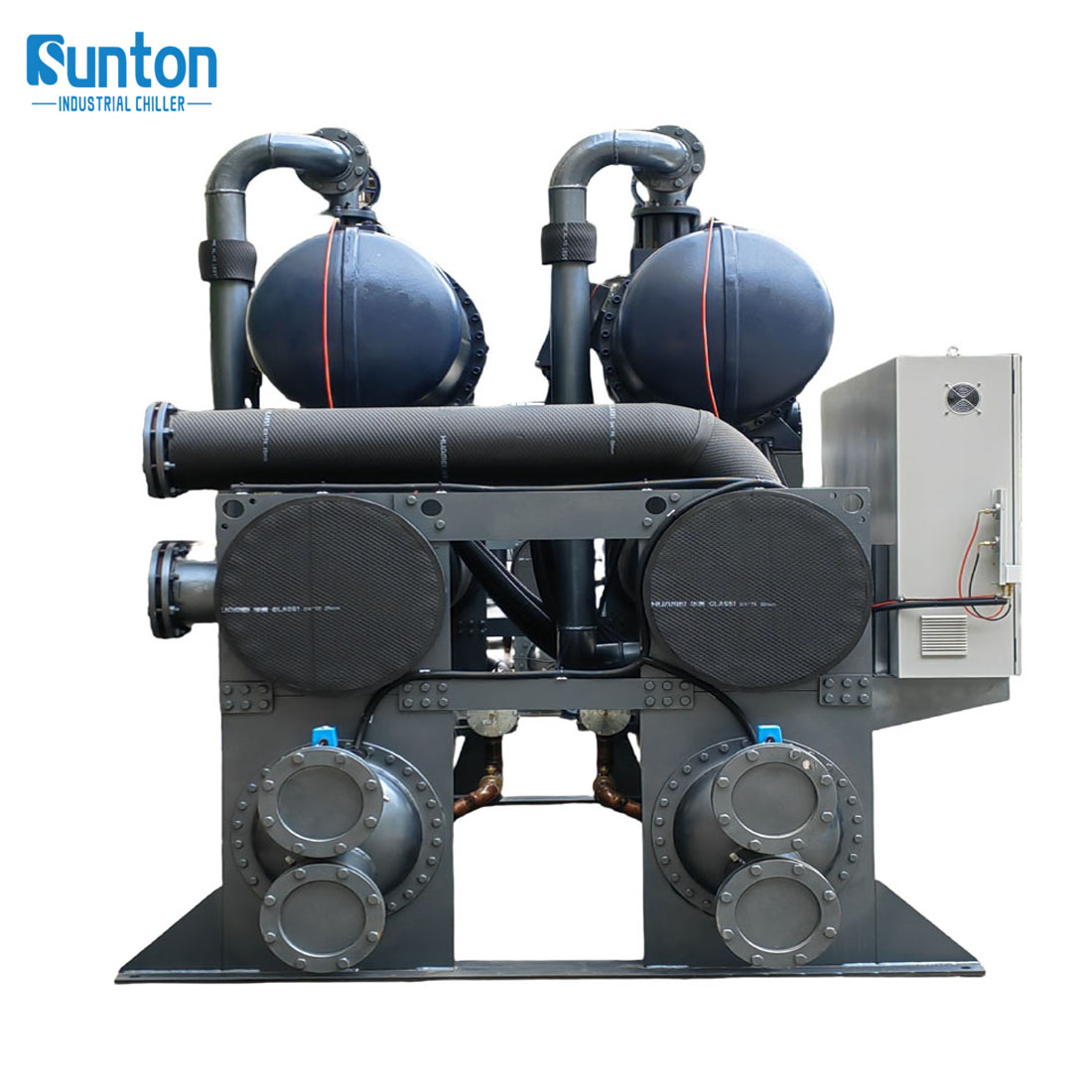
চিলারের দক্ষতা এবং কর্মক্ষমতাকে কোন বিষয়গুলি প্রভাবিত করে?
বেশ কিছু কারণ প্রভাবিত করে শীতল দক্ষতা এবং কর্মক্ষমতা, নির্বিশেষে চিলারের ধরণএর মধ্যে রয়েছে শীতলকারী নকশা, অপারেটিং অবস্থা, রক্ষণাবেক্ষণ পদ্ধতি এবং ব্যবহৃত উপাদানগুলির গুণমান। চিলার দক্ষতা প্রায়শই এর কর্মক্ষমতা সহগ (COP) বা শক্তি দক্ষতা অনুপাত (EER) দ্বারা পরিমাপ করা হয়। উচ্চতর COP বা EER উন্নত দক্ষতা নির্দেশ করে।
পরিবেষ্টিত বায়ু তাপমাত্রা কার্য সম্পাদনে গুরুত্বপূর্ণ ভূমিকা পালন করে এয়ার-কুলড চিলার। যেমন বাতাসের তাপমাত্রা উঠে যায়, শীতলকারীতাপ প্রত্যাখ্যান করার ক্ষমতা হ্রাস পায়, যার ফলে দক্ষতা হ্রাস পায়। জল-ঠান্ডা চিলার এই সমস্যাটির প্রতি কম সংবেদনশীল, তবে তারা দক্ষতার উপর নির্ভর করে কুলিং টাওয়ার এবং এর মান কনডেন্সার জলনিয়মিত রক্ষণাবেক্ষণ, যেমন পরিষ্কার করা কনডেন্সার কয়েল ইন এয়ার-কুলড চিলার এবং যথাযথ নিশ্চিত করা জল চিকিত্সা ভিতরে জল-ঠান্ডা সিস্টেম, সর্বোত্তম কর্মক্ষমতা বজায় রাখার জন্য অপরিহার্য।
আপনার নির্দিষ্ট চাহিদার জন্য সঠিক ধরণের চিলার কীভাবে বেছে নেবেন?
একটির মধ্যে নির্বাচন করা এয়ার-কুলড চিলার এবং একটি জল-ঠান্ডা চিলার আপনার আবেদনের জন্য নির্দিষ্ট বিভিন্ন বিষয়ের উপর নির্ভর করে। এখানে কিছু মূল বিবেচ্য বিষয় রয়েছে:
- শীতলকরণ ক্ষমতা: প্রয়োজনীয় নির্ধারণ করুন শীতলকরণ ক্ষমতা আপনার প্রক্রিয়ার জন্য। জল-ঠান্ডা চিলার সাধারণত উচ্চ লোডের জন্য বেশি উপযুক্ত।
- জলবায়ু: স্থানীয় জলবায়ু বিবেচনা করুন। এয়ার-কুলড চিলার অত্যন্ত গরম পরিবেশে লড়াই করতে পারে, যখন জল-ঠান্ডা চিলার ধারাবাহিকভাবে পারফর্ম করা।
- পানির প্রাপ্যতা: এর প্রাপ্যতা এবং খরচ মূল্যায়ন করুন পানিযদি জলের অভাব। অথবা দামি, একটি এয়ার-কুলড সিস্টেমটি আরও ব্যবহারিক হতে পারে।
- স্থান সীমাবদ্ধতা: উপলব্ধ স্থান মূল্যায়ন করুন। ক জল-শীতল চিলার প্ল্যান্ট দখল করে আরও জায়গা থাকার কারণে কুলিং টাওয়ার.
- বাজেট: তুলনা করুন প্রাথমিক খরচ এবং দীর্ঘমেয়াদী পরিচালন খরচ, যার মধ্যে শক্তি এবং রক্ষণাবেক্ষণ অন্তর্ভুক্ত।
- শব্দের সীমাবদ্ধতা: যদি শব্দ একটি উদ্বেগের বিষয় হয়, জল-ঠান্ডা চিলার সাধারণত শান্ত থাকে।
- পরিবেশগত নিয়ন্ত্রণ: স্থানীয় নিয়মকানুন বিবেচনা করুন জল ব্যবহার এবং শক্তি দক্ষতা।
- চিলার উপাদান
এই বিষয়গুলি সাবধানতার সাথে মূল্যায়ন করে, আপনি আপনার পরিচালনাগত চাহিদা এবং বাজেটের সাথে সামঞ্জস্যপূর্ণ একটি সুচিন্তিত সিদ্ধান্ত নিতে পারেন। শিল্পের সাথে গভীরভাবে জড়িত একজন ব্যক্তি হিসেবে, আমি সর্বদা ক্লায়েন্টদের দীর্ঘমেয়াদী চিন্তা করার পরামর্শ দিই। যদিও প্রাথমিক খরচ গুরুত্বপূর্ণ, মালিকানার মোট খরচ বিবেচনা করাও সমানভাবে গুরুত্বপূর্ণ শীতলকারীএর জীবনকাল।
এয়ার-কুলড এবং ওয়াটার-কুলড চিলারের রক্ষণাবেক্ষণের প্রয়োজনীয়তাগুলি কী কী?
যেকোনো জিনিসের দীর্ঘায়ু এবং দক্ষতা নিশ্চিত করার জন্য সঠিক রক্ষণাবেক্ষণ অত্যন্ত গুরুত্বপূর্ণ শীতলকারী. এয়ার-কুলড চিলার সাধারণত এর চেয়ে কম রক্ষণাবেক্ষণের প্রয়োজন হয় জল-ঠান্ডা ইউনিট। নিয়মিত কাজের মধ্যে রয়েছে পরিষ্কার করা কনডেন্সার কয়েল, পরীক্ষা করা রেফ্রিজারেন্ট স্তর, এবং ভক্তদের পরিদর্শন। এই কাজগুলি কর্মক্ষমতা হ্রাস রোধ করতে এবং প্রসারিত করতে সহায়তা করে শীতলকারীএর জীবনকাল।
জল-ঠান্ডা চিলার আরও জড়িত রক্ষণাবেক্ষণের প্রয়োজন কারণ পানি সিস্টেম। নিয়মিত জল চিকিত্সা স্কেলিং, ক্ষয় এবং জৈবিক বৃদ্ধি রোধ করার জন্য এটি অপরিহার্য, যা দক্ষতার উপর উল্লেখযোগ্যভাবে প্রভাব ফেলতে পারে। কুলিং টাওয়ার পর্যায়ক্রমিক পরিষ্কার এবং পরিদর্শনেরও প্রয়োজন। রক্ষণাবেক্ষণ খরচ জন্য জল-ঠান্ডা চিলার উচ্চতর, সঠিক রক্ষণাবেক্ষণ নির্ভরযোগ্য কর্মক্ষমতা নিশ্চিত করে এবং ব্যয়বহুল ভাঙ্গন রোধ করতে পারে।
চিলার প্রযুক্তির ভবিষ্যৎ: দিগন্তে কী আছে?
দ্য শীতলকারী প্রযুক্তির অগ্রগতি এবং জ্বালানি দক্ষতা এবং পরিবেশগত স্থায়িত্বের উপর ক্রমবর্ধমান মনোযোগের দ্বারা পরিচালিত শিল্প ক্রমাগত বিকশিত হচ্ছে। আমরা নতুনত্ব দেখতে পাচ্ছি রেফ্রিজারেন্ট প্রযুক্তি, কম বৈশ্বিক উষ্ণায়নের সম্ভাবনা (GWP) রেফ্রিজারেন্টের দিকে পরিবর্তনের সাথে। কম্প্রেসার ডিজাইন এবং নিয়ন্ত্রণ ব্যবস্থার উন্নতিও উচ্চ দক্ষতার স্তরে অবদান রাখছে।
আরেকটি প্রবণতা হল স্মার্ট প্রযুক্তির ক্রমবর্ধমান ব্যবহার শীতলকারী সিস্টেম। এই প্রযুক্তিগুলি রিয়েল-টাইম পর্যবেক্ষণ, ভবিষ্যদ্বাণীমূলক রক্ষণাবেক্ষণ এবং দূরবর্তী ডায়াগনস্টিকসের সুযোগ করে দেয়, যা ডাউনটাইম উল্লেখযোগ্যভাবে হ্রাস করতে পারে এবং কর্মক্ষমতা সর্বোত্তম করতে পারে। একটি প্রস্তুতকারক হিসাবে, আমরা ক্রমাগত আমাদের পণ্যগুলিকে উন্নত করার এবং আমাদের ক্লায়েন্টদের সবচেয়ে উন্নত এবং দক্ষ সরবরাহ করার জন্য নতুন উপায়গুলি অন্বেষণ করছি। শীতলকরণ সমাধান উপলব্ধ।
সচরাচর জিজ্ঞাস্য
১. এয়ার-কুলড এবং ওয়াটার-কুলড চিলারের মধ্যে প্রধান পার্থক্য কী?
প্রাথমিক এয়ার কুলড চিলার এবং ওয়াটার কুলড চিলারের মধ্যে পার্থক্য তাপ অপচয় করার জন্য ব্যবহৃত পদ্ধতি। এয়ার-কুলড চিলার পরিবেশগত বায়ু ব্যবহার করুন, যখন জল-ঠান্ডা চিলার ব্যবহার করুন a জলের উৎস, যেমন একটি কুলিং টাওয়ার, তাপ অপসারণ করতে রেফ্রিজারেন্ট.
২. জল-ঠান্ডা চিলারগুলি কি এয়ার-ঠান্ডা চিলারের চেয়ে বেশি দক্ষ?
সাধারণত, হ্যাঁ। জল-ঠান্ডা চিলার সাধারণত বেশি দক্ষ, বিশেষ করে উষ্ণ জলবায়ুতে। তাদের কর্মক্ষমতা সহগ (COP) বেশি এবং তাপমাত্রার ওঠানামার দ্বারা কম প্রভাবিত হয় পরিবেশগত বায়ু তাপমাত্রা। আমাদের বিস্ফোরণ-বিরোধী চিলার উন্নত শীতল প্রযুক্তির মাধ্যমে দক্ষতা বৃদ্ধির প্রমাণ।
৩. এয়ার-কুলড চিলারের জন্য কি জল সরবরাহের প্রয়োজন হয়?
না, এয়ার-কুলড চিলারের প্রয়োজন হয় না ক জল সরবরাহ। তারা পরিবেশগত বায়ু ব্যবহার করে শীতলকরণ, তাদের এমন জায়গাগুলির জন্য উপযুক্ত করে তোলে যেখানে পানি সীমিত বা কোথায় জল সংরক্ষণ একটি অগ্রাধিকার।
৪. ওয়াটার-কুলড চিলারের রক্ষণাবেক্ষণের প্রয়োজনীয়তাগুলি কী কী?
জল-শীতল চিলারের প্রয়োজন নিয়মিত জল চিকিত্সা স্কেলিং, ক্ষয় এবং জৈবিক বৃদ্ধি রোধ করতে। কুলিং টাওয়ার পর্যায়ক্রমিক পরিষ্কার এবং পরিদর্শনেরও প্রয়োজন। যদিও রক্ষণাবেক্ষণের চেয়ে বেশি জড়িত এয়ার-কুলড ইউনিট, এটি সর্বোত্তম কর্মক্ষমতা এবং দীর্ঘায়ু নিশ্চিত করে।
৫. কোন ধরণের চিলার পরিবেশ বান্ধব?
এটা নির্দিষ্ট পরিস্থিতির উপর নির্ভর করে। জল-ঠান্ডা চিলার বেশিরভাগ পরিস্থিতিতে কম শক্তি ব্যবহার করে কিন্তু উল্লেখযোগ্য পরিমাণে শক্তির প্রয়োজন হয় পানি. এয়ার-কুলড চিলার সংরক্ষণ করা পানি কিন্তু কম শক্তি-সাশ্রয়ী হতে পারে, বিশেষ করে গরম জলবায়ুতে। পছন্দটি শক্তি এবং উভয় বিবেচনা করা উচিত পানি সংরক্ষণ লক্ষ্য।
৬. গরম আবহাওয়ায় কি এয়ার-কুলড চিলার ব্যবহার করা যেতে পারে?
হ্যাঁ, কিন্তু কিছু সতর্কতা সহ। এয়ার-কুলড চিলার গরম জলবায়ুতে কাজ করতে পারে, কিন্তু তাদের দক্ষতা হ্রাস পায় কারণ পরিবেশগত বায়ু তাপমাত্রা বৃদ্ধি পায়। সর্বোত্তম কর্মক্ষমতার জন্য সঠিক আকার পরিবর্তন এবং নির্দিষ্ট জলবায়ু পরিস্থিতি বিবেচনা করা অপরিহার্য।
কী Takeaways
- চিলার প্লাস্টিক, খাদ্য, রাসায়নিক এবং ডেটা সেন্টার সহ বিভিন্ন শিল্পে তাপমাত্রা নিয়ন্ত্রণের জন্য এটি অপরিহার্য।
- এয়ার-কুলড চিলার ব্যবহার পরিবেশগত বায়ু থেকে শীতল দ্য রেফ্রিজারেন্ট, যখন জল-ঠান্ডা চিলার ব্যবহার করুন a পানি উৎস যেমন একটি কুলিং টাওয়ার.
- জল-ঠান্ডা চিলার সাধারণত বেশি দক্ষ কিন্তু নির্ভরযোগ্য প্রয়োজন পানি সরবরাহ এবং আরও রক্ষণাবেক্ষণ।
- এয়ার-কুলড চিলার কম আছে প্রাথমিক খরচ এবং ইনস্টল করা সহজ কিন্তু গরম জলবায়ুতে কম কার্যকর হতে পারে।
- ডান নির্বাচন করা শীতলকারী যেমন বিষয়গুলির উপর নির্ভর করে শীতলকরণ ক্ষমতা, জলবায়ু, পানি প্রাপ্যতা, বাজেট এবং পরিবেশগত বিবেচনা।
- উভয়ের দীর্ঘায়ু এবং দক্ষতা নিশ্চিত করার জন্য সঠিক রক্ষণাবেক্ষণ অত্যন্ত গুরুত্বপূর্ণ এয়ার-কুলড এবং জল-ঠান্ডা চিলার.
- ভবিষ্যৎ শীতলকারী প্রযুক্তির মধ্যে রয়েছে অগ্রগতি রেফ্রিজারেন্ট প্রযুক্তি, কম্প্রেসার ডিজাইন এবং স্মার্ট নিয়ন্ত্রণ ব্যবস্থা।
একটির মধ্যে নির্বাচন করা এয়ার-কুলড চিলার এবং একটি জল-ঠান্ডা চিলার এটি একটি গুরুত্বপূর্ণ সিদ্ধান্ত যা আপনার কার্যক্রমকে উল্লেখযোগ্যভাবে প্রভাবিত করতে পারে। প্রতিটি ধরণের পার্থক্য, সুবিধা এবং বিবেচনাগুলি বোঝার মাধ্যমে, আপনি আপনার নির্দিষ্ট চাহিদা এবং দীর্ঘমেয়াদী লক্ষ্যগুলির সাথে সামঞ্জস্যপূর্ণ একটি সচেতন পছন্দ করতে পারেন। শিল্পের একটি শীর্ষস্থানীয় প্রস্তুতকারক হিসাবে জল চিলার, আমরা আমাদের ক্লায়েন্টদের সবচেয়ে উন্নত এবং দক্ষ প্রদান করতে প্রতিশ্রুতিবদ্ধ শীতলকরণ সমাধান উপলব্ধ। যদি আপনি আপনার অপ্টিমাইজ করতে প্রস্তুত হন শীতলকরণ প্রক্রিয়া এবং সেরা অন্বেষণ শীতলকারী আপনার শিল্পের জন্য বিকল্পগুলির জন্য, আজই আমাদের সাথে যোগাযোগ করুন। আসুন আপনার পরিচালনাগত লক্ষ্যগুলি দক্ষতার সাথে এবং টেকসইভাবে অর্জনের জন্য একসাথে কাজ করি।
